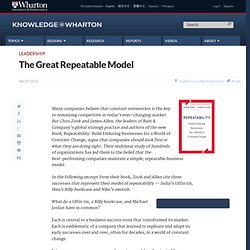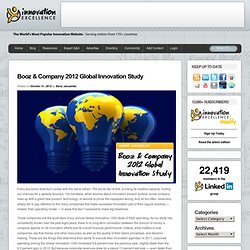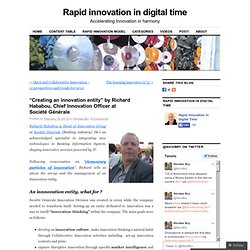

Organisational Culture. Organizational Culture Change: Use OCAI. Organisational culture. McNeill (2007) Hofstede's Organizational Culture Dimensions. The Great Repeatable Business Model. Idea in Brief Really successful companies build their strategies on a few vivid and hardy forms of differentiation that act as a system and reinforce one another.

They grow in ways that exploit their core differentiators by replicating them in new contexts. And they turn the sources of their differentiation into routines, behaviors, and activity systems that everyone in the organization can understand and follow. Powerful differentiations deliver enduring profits only when they are supported by simple, nonnegotiable principles and robust learning systems that drive constant improvement across the business. Differentiation is the essence of strategy, the prime source of competitive advantage. The sharper your differentiation, the greater your advantage. The Great Repeatable Leader - Chris Zook. By Chris Zook | 8:46 AM February 23, 2012 Admiral Lord Nelson, Britain’s famous naval leader, owed his enviable record of victories to the ability of his officers to make synchronized decisions in the heat of battle without communicating directly.

These commanders, personally trained by Nelson, he called his “band of brothers” and they took the right decisions because they knew what he would do in their shoes. By projecting his key principles of decision making and his strategy out to the front line Nelson created a faster and more adaptable Royal Navy that regularly overwhelmed far larger enemies. Few businesses are like Nelson’s Navy.
Rather than speeding up their decision-making, they’re slowing down. Here’s how it works. How can leaders prevent this from happening? To find the answer to that question I attended a session on leadership at the World Economic Forum in Davos. The Great Repeatable Model. Many companies believe that constant reinvention is the key to remaining competitive in today’s ever-changing market.

But Chris Zook and James Allen, the leaders of Bain & Company’s global strategy practice and authors of the new book, Repeatability: Build Enduring Businesses for a World of Constant Change, argue that companies should look first at what they are doing right. Their multiyear study of hundreds of organizations has led them to the belief that the best-performing companies maintain a simple, repeatable business model. In the following excerpt from their book, Zook and Allen cite three successes that represent their model of repeatability — India’s tiffin tin, Ikea’s Billy bookcase and Nike’s swoosh.
What do a tiffin tin, a Billy bookcase, and Michael Jordan have in common? Each is central to a business success story that transformed its market. Booz & Company 2012 Global Innovation Study. Every economic downturn comes with the same refrain: The world, we’re told, is losing its creative capacity, hurting our chances for a speedy recovery.

Yet inevitably, when worries about innovation erosion surface, some company rises up with a great new product, technology, or service to prove the naysayers wrong. And all too often, observers simply fail to pay attention to the many companies that make successful innovation part of their regular practice — indeed, their operating model — in ways that don’t necessarily make big headlines. Those companies are the quiet stars of our annual Global Innovation 1000 study of R&D spending. As our study has consistently shown over the past eight years, there is no long-term correlation between the amount of money a company spends on its innovation efforts and its overall financial performance; instead, what matters is how companies use that money and other resources, as well as the quality of their talent, processes, and decision making.
“Creating an innovation entity” by Richard Hababou, Chief Innovation Officer at Société Générale. Richard Hababou is Head of Innovation Group at Société Générale (Banking industry).

He’s an acknowledged specialist in integrating new technologies in Banking Information System, shaping innovative services powered by IT. Following conversation on “elementary particles of innovation“, Richard tells us about the set-up and the management of an Innovation entity. An innnovation entity, what for ? Société Générale Innovation Division was created in 2009 while the company needed to transform itself. Setting-up an entity dedicated to innovation was a way to instill “innovation thinking” within the company. When Innovation Fails. Is Organization the Enemy of Creativity? In the May issue of Inc., a reader, Elaine Ellis, poses a great question: Is creativity stifled by organization or is it easier to be creative at a company that is extremely well run?

" The way she phrases the question to some degree defines the answer. Of course it is easier to be creative in a "well run" company because it is easier to get things done and to experiment. Truly creative people don't baulk at every restraint; the best people I've ever worked with understood the necessity and found structure provoked them to do richer and more daring work. Prize-winning playwrights appreciate that their broadcast work has to run to time. Great painters appreciate the demands of specific spaces. But inside Ellis's question is, I think, another important question: Does focus on perfect processes displace concern for originality and innovation? Many companies suffer from managerial narcissism. But of course the opposite can happen. Process doesn't have to be perfect. Repeatability: Building Enduring Business - Jason Sylva - HBR Events.